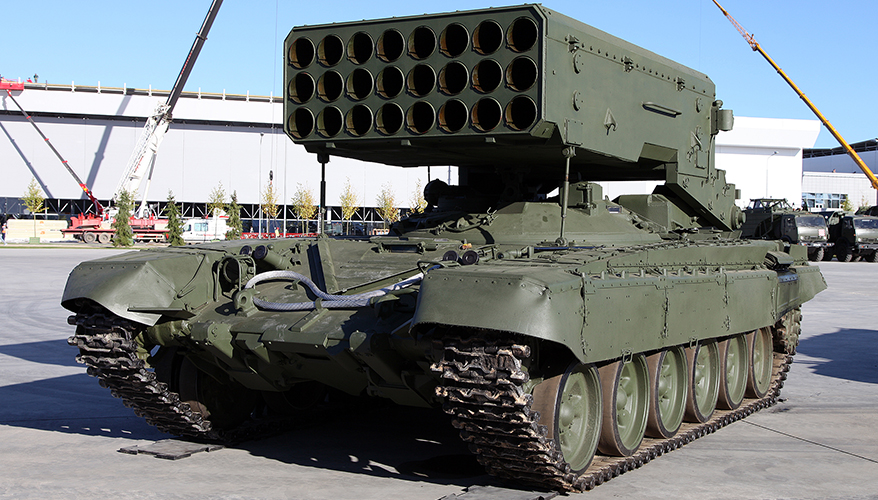Sean Carberry

Vitaly V. Kuzmin photo via Wiki commonsWASHINGTON, D.C. — U.S. sanctions and export controls are intended to prevent rivals from obtaining semiconductors and other sensitive electronics, yet dozens of weapon systems Russia has deployed against Ukraine are loaded with — and can’t function without — U.S. and Western electronics, according to a U.K. think tank.
Radars, electronic warfare technology, missiles and guidance systems — even secure communications devices — are among the 27 different systems Russia has used in Ukraine found to contain western electronics, Jack Watling, a fellow with the Royal United Services Institute, or RUSI, said during a Jan. 26 presentation at the Wilson Center think tank in Washington, D.C.
In the early days of the war, Watling was on the ground in Ukraine and met with a Ukrainian general who presented a salvaged computer box from a Russian 9M727 missile. “And as he went through the layers of chipboards, he started pointing out all of the chips that were manufactured in the United States, which was a very significant proportion of them,” he said.
That began the process of cataloging the foreign components the think tank found in Russian systems.
One was the radar for a Russian air defense system, he said. “As a military analyst, I had spent weeks trying to work out how to defeat these systems, only to realize that actually the critical components in them were not just Western made, but in many cases, export control components — components that we have been trying to prevent getting into Russia.”
While many of the systems they analyzed were legacy systems, some electronics components were from 2021, he noted.
Over the years, Russia has developed a robust — if sometimes deceptively simple — system of evading sanctions and illegally obtaining technology, panelists said.
“A lot of our sanctions processes have been around attacking companies,” Watling said. “But the infrastructure is fundamentally built around people, not companies. It's been built for a very long time. It's been operating for a very long time. And we're doing far less to degrade that infrastructure.”
It can be as simple as Russian agents making purchases in the United States, shipping the components to themselves at a U.S. address, then repackaging and sending the components to Russia via shell companies and intermediaries, often based in Hong Kong and Turkey, panelists at the presentation said.
They found that the current approach Russia is using to circumvent export controls is straight out of the playbook the Soviets developed in the early days of the Cold War.
“We've actually identified a number of commonalities of these procurement networks, most notably the use of transshipment hubs to try to circumvent some of these export controls and sanctions were already in place prior to invasion, and now much more stringent following that,” said Gary Somerville, research fellow at RUSI.
The use of western electronics allows Russia to create modern weapons, but that comes at a price, said James Byrne, director of open-source intelligence and analysis at RUSI. “It also introduces a critical vulnerability into their systems, which is: we have control over some of the ultimate technology in their supply chains.”
Therefore, if the west can interdict the illicit supply chains, that can greatly diminish Russia’s capability and its efforts to rearm as it blows through its weapons stocks, he said. Removing just one type of chip from the supply chain could set back production of a weapon or missile by months, he added.
That is no small task, given that RUSI’s research turned up 450 microelectronics components in the Russian systems, and 81 of the components had export control numbers. They also found Japanese capacitors, British oscillators and Dutch pressure sensors in the Russian weapons. Furthermore, Iranian weapons and most likely North Korean and Chinese weapons are also full of Western electronics.
“We think there have been definite successes in slowing these exports down,” Byrne said. “There have been a range of people that have been indicted. There are a range of people that have been sanctioned, [and] have been pursued by the authorities.”
However, agencies in the west are under resourced and using legacy tracking systems, he noted.
Somerville added that “export control is very reactive at the moment, and what we are [facing] here is an adversary who is proactively working their way around the gaps.”
Some of the mechanisms built during the war on terror to share information across agencies and countries could make a difference, but “that doesn't really exist within the export control space,” he added.
Panelists said that there is a tremendous amount of open-source data that RUSI and others are using to track the problem. They can buy data sets of customs records, shipping transactions and corporate records and use artificial intelligence to find evidence of criminal activity.
“So, because there's so much data out there it’s just a question of fusing it and doing the analysis and turning the product out in a speedy timely way,” Byrne said.
The ideal solution, said Watling, is for covert intelligence officers to coordinate with open-source centers to alert them where they should be watching so they can flag anomalies in real time.
“You don't need to reveal that there was some classified collection that that cued you on, but it means that in the ocean of open-source information, you can really rapidly build datasets that you can share,” he said. That way, the moment someone tries to buy something, “the indicators and warnings come on, and the person can be blown before they succeed.”
No comments:
Post a Comment